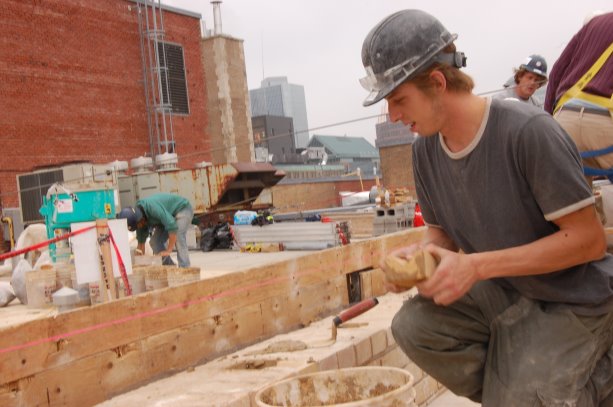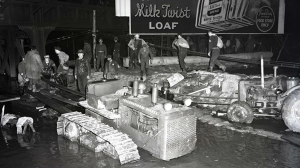Restoring heritage buildings is more than just a job for third-year brick and stonemason apprentices Nate Lyons-Fisher and Brian Shepherd.
Both work for Toronto-based Historic Restoration Inc. and it may be safe to suggest their fellow employees and colleagues in other restoration firms share their passion for saving this country’s dwindling stock of older buildings.
"I can say learning to work for a client who wants work done for the sake of maintaining something beautiful and significant to its community is truly enlightening and, as far as I can tell, a rare privilege in the Canadian building industry," says Lyons-Fisher
Following university, he worked at a series of restaurant and construction related jobs, eventually finding work with a small residential masonry restoration firm. Then he enrolled in a one-year Sustainable Building and Design Course at Sir Sandford Fleming College in Haliburton, Ont. where he helped build a straw bale market store.
"It was certainly a formative experience for me," says Lyons-Fisher, explaining the project introduced students to a variety of alternative mechanical and structural building systems.
After returning to Toronto, he participated in a masonry seminar sponsored by Historic Restoration and was hired as as apprentice in November 2012.
Much of his apprenticeship has been spent working on buildings in Toronto’s historic Distillery District, but it has also included projects where he was exposed to modern masonry construction.
"I’ve been given the chance to develop the physical mechanics and mental approach to work that is expected of a tradesperson," says Lyons-Fisher, explaining he likes being part of a trade which is doing something relevant and important.
"It (building restoration) is a non-political way of making a difference."
In April of this year he received a major promotion when he was appointed junior foreman of the crew which is restoring Little Trinity Anglican Church, the oldest surviving church in Toronto. Some of the work carried out to date has included repointing and rebuilding column bases and panels around the entire church.
"This job has been a learning curve. But I’ve learned a lot," says Lyons-Fisher, adding this is his first management position.
For Shepherd the road to an apprenticeship career began in 2006 when he obtained a summer job with a landscape contractor.
A journeyman mason taught him the stone aspects of the trade, "which I took an immediate interest in. The more I learned about stone masonry the more passion I gained."
Historic Restoration is conducting a multi-year exterior restoration of Toronto’s landmark King Edward Hotel and that’s where Shepherd says he has obtained valuable and extensive experience. The hotel has a diverse mix of cladding materials including brick, Indiana Limestone, terra cotta and block, he explains.
For example, the entire terra cotta section was either entirely removed or ‘Dutchman repaired’, which is the technique of replacing faulty portions with new stone.
"We replaced brickwork on the east side of the building matching brick and mortar colours, along with replacing the damaged terracotta pieces on the northeast corner and the front of the building."
But Shepherd has worked on numerous other sites as part of the contractor’s policy of rotating apprentices. The rotation ensures they have the opportunity to work with — and learn from — different journeymen, says partner Paul Goldsmith.
Including his son Tyler, 20, the company now has seven apprentices. One of those seven is Joel Yeomans, a high school friend of Tyler’s who encouraged him to enter the trade.
Their on-the-site experience is complemented with two-month academic training at the Ontario Masonry Training Centre in Mississauga every year of the three-year apprenticeship.
In selecting potential apprentices, Goldsmith says the company prefers potential candidates to work as a mason’s helper for a few months before entering into an apprenticeship agreement.
"If the candidate exhibits good work ethics, practical skills, problem solving ability, common sense and an interest in the trade as well as the history and traditions of the masonry trade then we consider them for apprenticeship training."
Some have completed heritage masonry programs at schools elsewhere or pre-apprenticeship programs before joining the firm.
Simply wanting to make money is not a good enough reason for considering a brick and stonemason career, says Goldsmith.











Recent Comments
comments for this post are closed